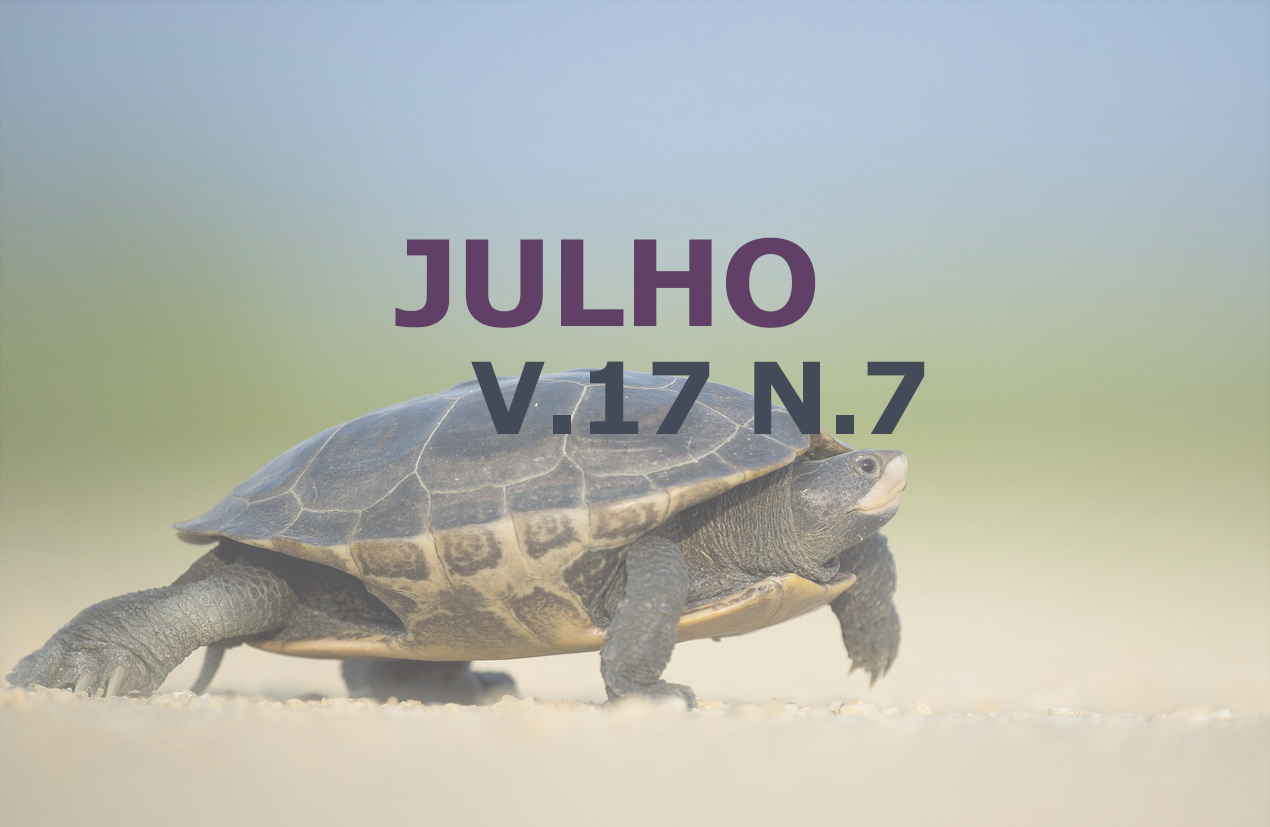Treatment of feline isosporosis with ponazuril: Case report
DOI:
https://doi.org/10.31533/pubvet.v17n7e1415Keywords:
Feline Isosporosis, Isospora spp, ponazurilAbstract
The occurrence of gastrointestinal parasites in cats is reported with great frequency, especially when it comes to animals with outdoor access, or living in overcrowded environments, such as catteries and shelters. Infection byIsospora spp in cats begins with the ingestion of sporulated oocysts in the environment or tissues from other infected intermediate vertebrate hosts. Diagnosis is based on the detection of oocysts in cat feces and clinical signs. The recommended treatment for coccidiosis in cats is sulfonamides. Other drugs have been studied as secondary lines of treatment, which is the case of ponazuril and toltrazuril, which have been used in animals to treat isosporosis, toxoplasmosis, neosporosis and equine protozoal meningoencephalitis. There are anecdotal reports of the use of ponazuril in treating Isospora spp. In this study, 21 cats were treated with ponazuril, which proved effective in controlling the disease, since 100% of the cats treated were negative in the coproparasitological examination after the three days of treatment with a dose of 50 mg/kg SID. Furthermore, the animals had considerable improvement in stool consistency after the dosing period.
References
Amaral, V., Amaro, R. G., & Birgel, E. H. (1966). Ocorrência da Isospora felis Wenyon, 1923, em suçuarana (Puma concolor). Revista Da Sociedade Paulista de Medicina Veterinária, 4(1), 25–28.
Bowman, D. D. (2010). Parasitologia veterinária. Elsevier.
Companion Animal Parasite Council, 2014. http://www.capcvet.org/ capc-recommendations/coccidia (acesso 10/2022).
Dubey, J. P. (2010). Toxoplasmosis of Animals and Humans. Boca Raton, CRC Press.
Dubey, J. P., & Jones, J. L. (2008). Toxoplasma gondii infection in humans and animals in the United States. International Journal for Parasitology, 38(11), 1257–1278. https://doi.org/10.1016/j.ijpara.2008.03.007
Ferraz, A., Pires, B. S., Santos, E. M., Evaristo, T. A., Castro, T. A., Dallmann, P. R. J., Nobre, M. O., & Nizoli, L. Q. (2019). Frequência de parasitos gastrintestinais, presentes em fezes de cães e gatos, analisadas no laboratório de doenças parasitárias da UFPEL, durante o ano de 2017. Science And Animal Health, 7(1), 41–53. https://doi.org/10.15210/sah.v7i1.14786
Fortes, E. (2004). Parasitologia Veterinária (4a ed.). Cone Editora.
Furr, M., & Kennedy, T. (2000). Cerebrospinal fluid and blood concentrations of toltrazuril 5% suspension in the horse after oral dosing. Veterinary Therapeutics: Research in Applied Veterinary Medicine, 1(2), 125–132.
Gennari, S. M., Kasai, N., Pena, H. F. J., & Cortez, A. (1999). Ocorrência de protozoários e helmintos em amostras de fezes de cães e gatos da cidade de São Paulo. Brazilian Journal of Veterinary Research and Animal Science, 36, 87–91. https://doi.org/10.1590/s1413-95961999000200006.
Kul, O., Yildiz, K., Ocal, N., Freyre, A., Deniz, A., Karahan, S., Atmaca, H. T., Gokpinar, S., Dincel, G. C., Uzunalioğlu, T., & Terzi, O. S. (2013). In-vivo efficacy of toltrazuril on experimentally induced Toxoplasma gondii tissue cysts in lambs: A novel strategy for prevention of human exposure to meat-borne toxoplasmosis. Research in Veterinary Science, 94(2), 269–276. https://doi.org/http://dx.doi.org/10.1016/j.rvsc.2012.08.001
Litster, A. L., Nichols, J., Hall, K., Camp, J., & Mohamed, A. S. (2014). Use of ponazuril paste to treat coccidiosis in shelter-housed cats and dogs. Veterinary Parasitology, 202(3–4), 319–325. https://doi.org/10.1016/j.vetpar.2014.03.003.
Marques, S. M. T., Oliveira, M. R. F. de, & Gomes, M. J. T. de M. (2017). Parasitos gastrintestinais em gatos da cidade de Porto Alegre, Rio Grande do sul. Pubvet, 11(11), 1132–1137. https://doi.org/10.22256/pubvet.v11n11.1132-1137
Mitchell, S. M., Zajac, A. M., Davis, W. L., & Lindsay, D. S. (2003). Mode of action of ponazuril against Toxoplasma gondii tachyzoites in cell culture. Journal of Eukaryotic Microbiology, 50, 689–690. https://doi.org/10.1111/j.1550-7408.2003.tb00689.x.
Rodrigues, A. N., & Menezes, R. (2003). Infecção natural de cães por espécies do gênero Cystoisospora (Apicomplexa: Cystoisosporinae) em dois sistemas de criação. Clínica Veterinária, 42, 24–30.
Saitoh, Y., & Itagaki, H. (1990). Dung beetles, Onthophagus spp., as potential transport hosts of feline coccidia. The Japanese Journal of Veterinary Science, 52(2), 293–297. https://doi.org/10.1292/jvms1939.52.293.
Sykes, J. E. (2013). Canine and feline infectious diseases-E-Book. Elsevier Health Sciences. https://doi.org/10.1016/C2009-0-41370-9.
Taylor, M. A., Coop, R. L., & Wall, R. L. (2017). Parasitologia Veterinária. Guanabara Koogan.
Tesserolli, G. L., Fayzano, L., & Agottani, J. V. B. (2005). Ocorrência de parasitas gastrintestinais em fezes de cães e gatos, Curitiba-PR. Revista Acadêmica, 3(4), 31–34. https://doi.org/10.7213/cienciaanimal.v3i4.9207.
Urquhart, G. M., Armour, J., Dunn, A. M., & Jennings, F. W. (1998). Parasitologia veterinária (2nd ed.). Guanabara Koogan.
Vasconcellos, M. S. D., Batista, L. C. S. O., Vidal, L. G. P., & Passos, M. M. (2013). Intensidade de infecção por Isospora spp. (Apicomplexa: Eimeriidae) em trinca-ferros-verdadeiros Saltator similis d’Orbigny, Lafresnaye (Passeriformes: Cardinalidae) mantidos em cativeiro no Município de Valença, Estado do Rio de Janeiro, Brasil. Coccidia, 1(2), 39–43. https://doi.org/10.51161/epidemion/7539
Wise, L. N., Ueti, M. W., Kappmeyer, L. S., Hines, M. T., White, S. N., Davis, W., & Knowles, D. P. (2012). In vitro activity of ponazuril against Theileria equi. Veterinary Parasitology, 185(2–4), 282–285. https://doi.org/10.1016/j.vetpar.2011.10.036.
Downloads
Published
Issue
Section
License
Copyright (c) 2023 Julia Fidencio Maestrello, Mariele Penegossi

This work is licensed under a Creative Commons Attribution 4.0 International License.
Você tem o direito de:
Compartilhar — copiar e redistribuir o material em qualquer suporte ou formato
Adaptar — remixar, transformar, e criar a partir do material para qualquer fim, mesmo que comercial.
O licenciante não pode revogar estes direitos desde que você respeite os termos da licença. De acordo com os termos seguintes:
Atribuição
— Você deve dar o crédito apropriado, prover um link para a licença e indicar se mudanças foram feitas. Você deve fazê-lo em qualquer circunstância razoável, mas de nenhuma maneira que sugira que o licenciante apoia você ou o seu uso. Sem restrições adicionais
— Você não pode aplicar termos jurídicos ou medidas de caráter tecnológico que restrinjam legalmente outros de fazerem algo que a licença permita.





